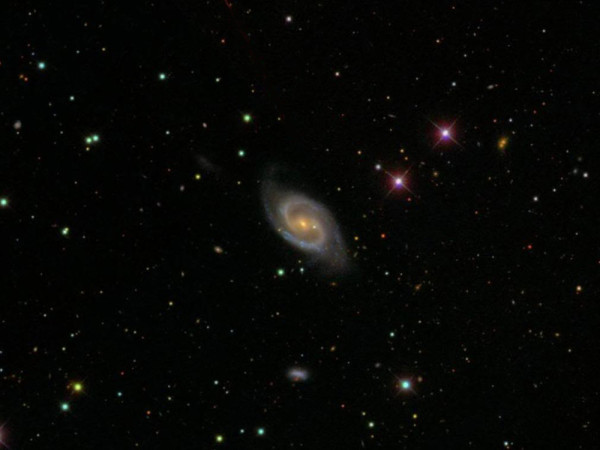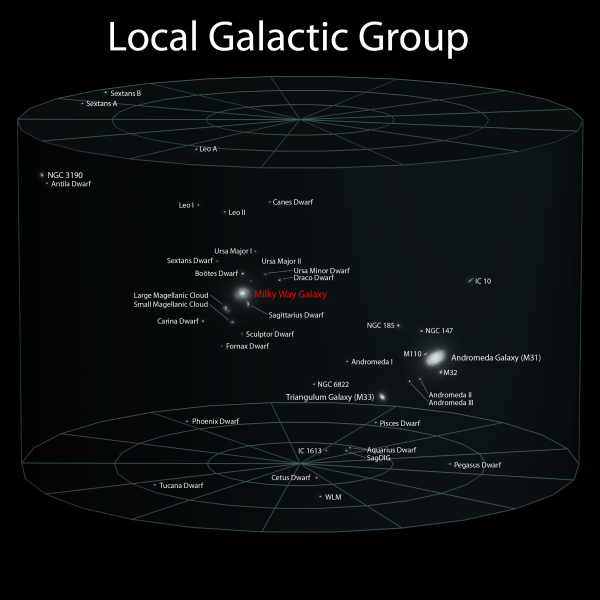“We live in a world that has narrowed into a neighborhood before it has broadened into a brotherhood.” -Lyndon B. Johnson
When you think of our own cosmic backyard -- our planets, Sun, the nearby stars, and even the closest galaxies to us -- you probably don't think of them in the context of the entire Universe. But if you want to understand where we come from and how we got to be this way, perhaps you ought to.
 Image credit: J. W. Inman, of NGC 2543, via http://www.jwinman.com/starcharts/NGC%202543%20chart.htm.
Image credit: J. W. Inman, of NGC 2543, via http://www.jwinman.com/starcharts/NGC%202543%20chart.htm.
We could have been a single, isolated galaxy hanging out all by our lonesome in the void: but we aren't. We could have been part of a large, rich cluster of galaxies, where the Milky Way was just one of many thousands like us: but we aren't. Instead, it's us, Andromeda, and about 50 other, much smaller neighbors, and no one else.
How did we come to be this way? Find out exactly what we are, and how that fits in to the cosmic story of everything around us. Come learn the science of the Local Group.
- Log in to post comments


"The question of where we come from is one that we’ve all wondered about, and is perhaps the most daunting philosophical question in all of existence. "
Bowwow goes full tilt in 3...2...1..
"The cold spots are regions of slightly more matter than average, while the hot spots are regions of slightly less matter than average."
I would think it be the opposite, due to thermal mass, what am I missing?
'ello, 'ello, 'ello. The link seems to end up somewhere else !
It reads https://medium.com only.
Yikes, and fixed!
AAH, now to enjoy ......
Hi Ethan,
"as isolated and remote as it is — we can perceive the entire Universe exactly as it is."
I would have thought it is our visible part of the universe we can perceive.
Ragtag:
GR tells us that a photon will be redshifted upon travelling from a region of higher gravitational potential to a region of lower gravitational potential. This is a consequence of energy conservation; photons with lower frequencies have less energy. The photon, like all other particles, loses energy when escaping from a gravitational field. A photon cannot slow down like a massive particle would. It must lose energy by decreasing in frequency.
When we speak of cold spots or hot spots in the CMB, we are really talking about variations in the frequency of the radiation. Cold spots are simply spots with slightly lower frequency; hot spots are the opposite. Since photons decrease in frequency whenever the leave a higher gravitational field, the cold spots must therefore be regions where there was a higher than normal gravitational field, ie. an overdensity of matter. The opposite, of course, holds true for hot spots.
Fail, rag. Quite a heavy load of fail.
@ #7 Sean T
Thanks Sean, Like this image from a week or so ago?
http://scienceblogs.com/startswithabang/files/2015/05/1-GhZO_U3L28rGW4s…
Hi Ethan,
The series of artistic renderings showing the merger of Andromeda and the Milky way are interesting, but it leaves me wondering a couple things.
1. Is this really accurate (in terms of how the sky would look at various points in our future)?
2. Will the Milky Way merge with any of the smaller galaxies in our local group before we merge with Andromeda?
3. If so, what would those mergers look like? Equally spectacular? After all, the other objects in the local group may be small compared to Andromeda, but they're still galaxies.
Re: #2, Eric, unless you're talking about the LMC and SMC then no, the others aren't coming our way (or us theirs, what with relativity and all).
Andromeda is pretty damn huge, remember, too. Probably 50% or more bigger than us, over double the next (IIRC). Peanuts compared to Virgo, but there's always one, isn't there..?
You'd have to speed things up a lot (and for preference be in a different galaxy) to see anything spectacular, however.
@ Wow, I thought I saw somewhere recently that the Milky way was more massive thanks to dark matter?
Well, you've read otherwise now!
Note: It's going to have dark matter too.
If you have something to the contrary, however, I'll listen. The estimates were far enough apart that there's no reason for me to suspect that someone found something different or a reason to change the order.
yep, your right.
It was an older article seems the last year they have made new more accurate measurements based on gravity and expansion rates.
Well, it's difficult to work it out. They only "recently" figured the Milky Way to be a barred spiral.When I were in school, it was a spiral, by the time I'd finished with university, it was a spiral with no more than three arms.
Frankly, it's probably easier to figure the mass of Andromeda.
The globular galaxies are a pretty good estimate, however.
Hi Ethan,
Always fascinating! Small quibble over this point, however:
"It took humanity thousands of years to understand that the Earth was round"
I've read that the idea that the ancients thought the Earth was flat is itself of pretty recent vintage; an idea popularized in the late 19th century, meant to denigrate the ancients. Most historians today operate on the understanding that thoughtful people even in antiquity and in every period since have known that the Earth was spherical.
This is not surprising: any fisherman working off the coast, and his relatives at home, could easily work out the curved nature of the Earth from the fact that their loved ones, after seeming to sink, actually came back over the horizon.
Thanks for these great articles - always an education!
@16: I agree with what you say, but its worth remembering that homo sapiens have been around basically unchanged for about 200,000 years. When Ethan said "thousands of years," I took him to be referencing the time it took human civilization to get to the level of the classical Greeks and their equivalents around the world, not the time from 500 BC to 1500 AD (roughly).
Eric, though technically right, most of those thousands of years they didn't care what shape the planet was (they knew the land wasn't flat: all them -ing hills they had to walk up and down was a clue) they just didn't care. It meant nothing to them. There was no mileage in wondering what shape the planet was when there's a lion who wants you eat your bumhole right outside your door.
So John is probably closer to correct mostly because for thousands of years, nobody had the time to wonder what the shape was, until they developed enough to work out religion, where someone could be closeted away from the need to worry about *lions* wanting your bumhole.
Those probably spend centuries with just the "obvious" idea the land was "flat, if you took the long view", more likely dish-shaped. To stop the water and silly people falling off the edge. But it wouldn't take much in the way of looking to see that things don't work that way. So the idea would be uncommon, then novel, then rising, then commonplace.
Among the privileged to still not to have to worry what is going to happen to their bumhole with respect to wildlife.
1) The moon is round. Spherical.
2) The shadow the earth makes on the moon indicates it's not circular.
And, after all, if magic stops the planets and sun and stars falling on the earth and killing everyone, then magic can be why people don't fall of the spherical earth.